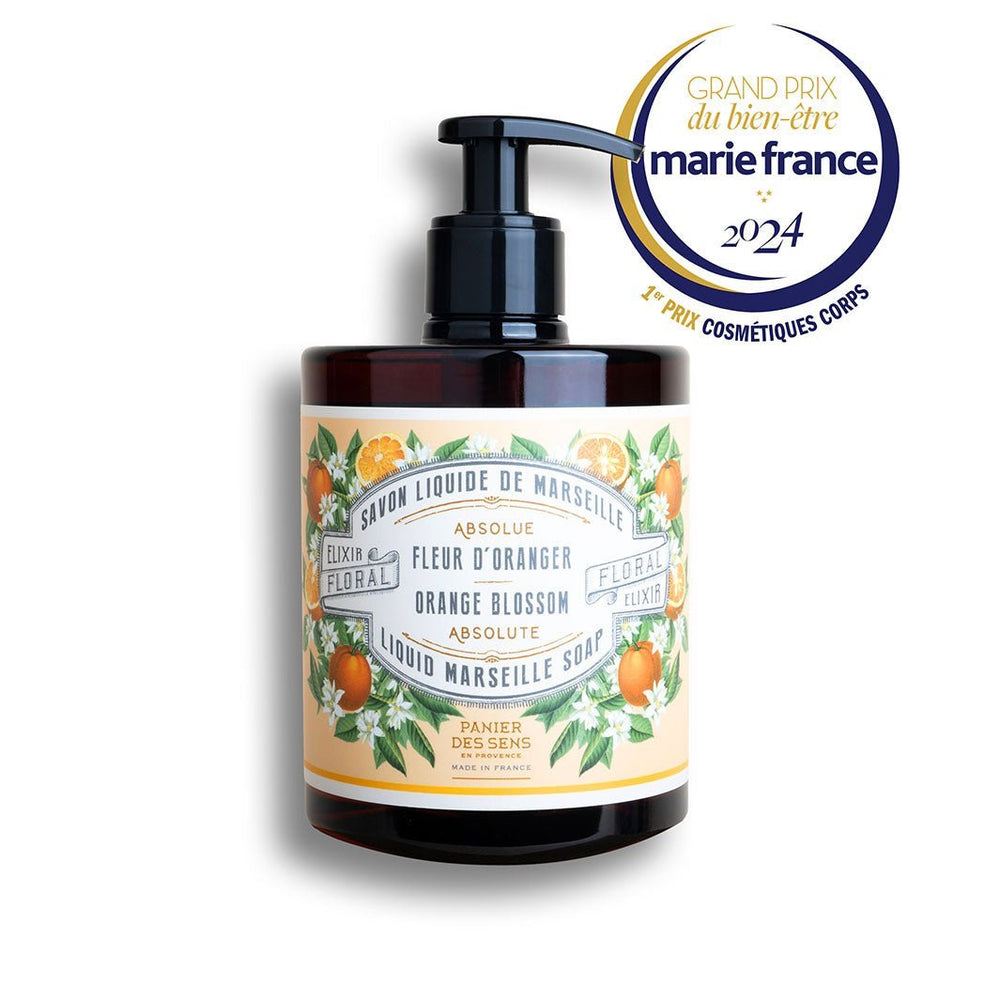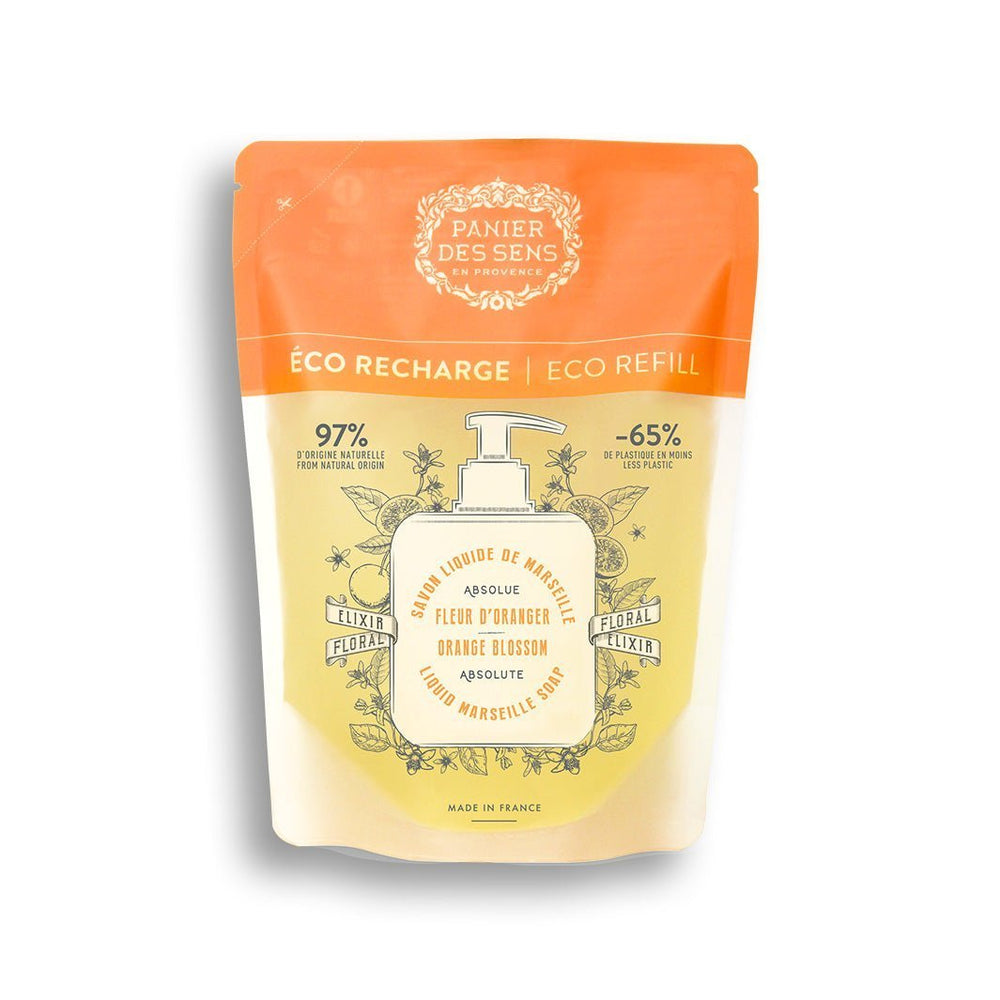How is liquid Marseille soap made?
Marseille soap is renowned for its cleansing properties and gentleness to the skin, but do we really know the process behind its transformation into liquid Marseille soap? In this informative text, we'll break down the age-old, painstaking process behind this much-loved hygiene product. From the fascinating story of its origin to the evolution of its form, we lift the veil on the origins and evolution of this universal cleanser.
We'll then explore the precise steps in saponification that transform natural ingredients into a creamy liquid. Then, we'll look at the essential components for which liquid Marseille soap is renowned, such as vegetable oils and potash. Knowing the composition criteria and perfuming techniques will help us discern a genuine liquid Marseille soap. Finally, we take a close look at the regulations and certifications that ensure the quality and authenticity of this product, as well as a foray into the world of fragrances, both traditional and modern, that enrich the sensory experience of liquid Marseille soap. To find out more about this treasure of Provence, discover the essential details in the article "Liquid Marseille soap: what you need to know".

What is the history of liquid Marseille soap?
The origins of Marseille soap
Marseille soap, with its aura of purity and authenticity, has a long history dating back to the 17th century. It was at this time that the port city became France's leading manufacturer of this precious amalgam, under the impetus of Colbert's decrees requiring that it be made exclusively from pure olive oils. This royal prerogative ruled out the use of any animal fats, giving Marseille soap a quality and renown that have endured down the ages.
The emblematic "extra pure, 72% oil" cube established itself as a standard of excellence during the 19th and early 20th centuries, before industrial upheavals shook its throne. Despite its decline in the face of synthetic detergents and the democratization of washing machines, this pillar of toiletry and housekeeping has been reborn in a form adapted to new ecological and practical requirements: liquid soap.
The evolution to liquid form
In the 1980s, faced with a market saturated with less environmentally-friendly products, Marseille soap experienced a notable revival of interest for its natural, biodegradable virtues. It was against this backdrop that its liquid version was born, the fruit of an ingenious adaptation designed to reconcile traditional craftsmanship with modern comfort. The ancestral formula is transformed into a creamy liquid that retains its original qualities while being easy to use on a daily basis.
This resurgence testifies not only to the adaptability of master soap-makers, but also to consumers' growing desire for authentic, environmentally-friendly products. So, despite the repeated assaults of industrial innovation, liquid Marseille soap continues to write its own history, gracefully blending age-old heritage with contemporary aspirations.
Steps in the saponification process for liquid Marseille soap
Preparing the ingredients
The making of liquid Marseille soap begins with an essential phase: the preparation of the ingredients. Master soap-makers carefully select vegetable oils, mainly olive oil, renowned for its moisturizing and softening properties. These oils are then preheated in imposing open-air cauldrons, a legacy of traditional methods that has endured for centuries.
Cooking and saponification
The next stage is saponification, or "empâtage", where the oils meet caustic soda under the influence of heat. It's in the heart of the cauldrons that this fascinating chemical reaction takes place, where the oils are transformed into a soapy paste, a prelude to the saponification process for liquid Marseille soap. This transformation requires careful monitoring and precise know-how to guarantee consistent quality.
Adding water and liquefaction
Once saponification is complete, it's time to move on to the washing stage. The resulting paste is rinsed with clear water to remove any residual traces of soda. It is also during this phase that sea salt is added to separate the glycerine naturally produced during the process. Finally, after several days of gentle cooking, comes the crucial moment: the addition of pure water, which allows the ancestral solid soap to metamorphose into the liquid form so appreciated today.
This succession of steps shows that behind every bottle of liquid Marseille soap lies an age-old art blended with contemporary ingenuity, the result of a proven recipe that respects both our skin and the environment.
The key ingredients of liquid Marseille soap
Vegetable oils
At the heart of liquid Marseille soap's timeless formula lies a Mediterranean treasure: olive oil. This precious essence, derived from the second pressing of olives, infuses the soap with its distinctive color and bewitching fragrance. Depending on the harvest, the soap oscillates between a green and brown hue, a reflection of the generous nature that gave birth to it. But Marseille soap's secret doesn't stop there: other vegetable oils are also added to enrich its virtues, bringing gentleness and respect to every use.
Potash and water
Pure water, the source of life, combines with potassium to trigger the alchemical process known as saponification. In this ancient reaction where elements are transformed, these two ingredients are essential to the creation of a liquid soap that cleanses effectively while preserving the delicate balance of our skin. Here, potash acts as an essential catalyst in the metamorphosis of oils into a cleansing substance.
Not to be confused with the process used to make solid soap, which combines caustic soda and water.
Any additives
Although the original Marseille soap recipe is remarkable for its simplicity, our homemade liquid version adds a few components chosen for their beneficial properties.
Although the original Marseille soap recipe is remarkable for its simplicity, our homemade liquid version adds a few components chosen for their beneficial properties.
Some premium and high-end liquid soaps contain added fragrance absolutes, such as Flower Orange BlossomOrange Blossom Geraniumor Jasmine. A veritable jewel of Haute Parfumerie, Absolue is the most precious essence of the plant raw material. Like an elixir, Absolue is obtained by cold extraction of the plant's fragrant molecules.
Essential oils can also be added to liquid Marseille soaps. They add fresh, natural and sensorial formulas to each composition. For example, essential oils of Lavender, Rose, Citrus, Fennel Marineor Verbena. Essential oils are obtained from botanically defined plant raw materials, either by steam distillation, dry distillation or cold expression.
Some soaps can be created without any additives, but directly from organic active ingredients from Provence. For example Grape, l'Almondor even Honey. To ensure irreproachable product quality and preserve a unique agricultural heritage, Certains savons de Marseille liquides preserve local agricultural heritage by working with local artisans and harvesters.
Are there regulations and certifications for making liquid Marseille soap?
French and European standards
In the teeming landscape of cosmetics, regulations play a lighthouse role, guiding both manufacturers and consumers towards safe, quality products. In the case of liquid Marseille soap, a mosaic of French and European standards meticulously governs its production. These rigorous guidelines ensure that every bottle that finds its way into your hands is synonymous with excellence. They scrutinize aspects such as composition, environmental impact and even labeling, ensuring transparency and trust.
How can you recognize genuine liquid Marseille soap?
Composition criteria
Faced with the multitude of products labelled "Marseille soap", it's legitimate to wonder how to identify an authentic version, especially when it comes to its liquid form. One infallible criterion lies in the soap's composition. A genuine liquid Marseille soap is based on a minimal, natural formula, using vegetable oils and no synthetic additives or artificial foaming agents. Purists will look for the predominant presence of olive oil, the olfactory and visual signature of traditional Marseille soap.
Product authentication
Authenticity also requires distinctive signs that trace the soap's origin and respect for ancestral processes. For this, the label must be examined: the name of the manufacturer must appear clearly, along with a statement that the soap was made in Provence using traditional methods. The true "Savon de Marseille" appellation implies that certain practices have been followed, such as cooking in a cauldron and composition based exclusively on vegetable oils.
Armed with the right clues, you'll be able to choose a soap that not only cleans effectively, but also carries with it an entire cultural and artisanal heritage.
What fragrances are available for liquid Marseille soap?
Liquid Marseille soap, an elixir of cleanliness and softness, is adorned with aromas that charm the senses and invite olfactory journeys. While tradition has given it an original note of olive oil, master soap-makers have explored a wider palette to enchant our daily lives.
Traditional perfumes and perfuming methods
The classic scents of liquid Marseille soap are drawn from the Provencal herbarium: soothing lavender, lemon and cypress or relaxing verbena. Other scents can also be used to perfume liquid Marseille soaps, such as rose, jasmine or even Orange Blossom. These natural essences are obtained using ancestral distillation or enfleurage methods, capturing the soul of the plants under the Mediterranean sun. Delicate perfuming takes place at the end of the saponification process to preserve the freshness and purity of the plant notes.
New olfactory trends
At the dawn of the 21st century, liquid Marseille soap reinvents itself and dares to take on contemporary fragrances. Alongside timeless classics, we're delighted to discover gourmet scents such as sweet almond, or exotic ones like green tea and Orange Blossom. The artisans also explore the benefits of aromatherapy, integrating essential oils with relaxing or invigorating properties. In this way, each bottle becomes a veritable olfactory jewel, transcending its primary role to offer a complete sensory experience.
This fragrant diversity not only responds to our personal desires, but also to our quest for a harmonious interior where each fragrance has its place. Whether you're looking for a moment of relaxation in the bathroom or a breath of fresh air in the kitchen, there's a liquid Marseille soap with aromas to create a unique atmosphere.
We recommend these other pages:





































